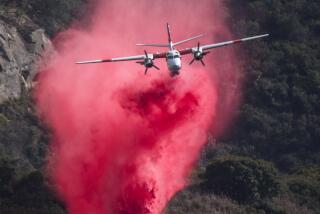Sky Kings : The Runways Aren’t Smooth, but Pilots Ensure Safe Landings on Channel Islands Flights
- Share via
SANTA CRUZ ISLAND — It is a bumpy ride down the dusty runway that cuts a long, straight line on a bluff overlooking the Pacific Ocean. But for some of Tom Driscoll’s passengers, that line is just not long enough.
Before any of them can say anything about it, Driscoll lets out the throttle of his trusty old twin-engine Britten-Norman Islander, and the plane is bouncing down the football field-size runway, kicking up dust.
Driscoll fiddles with the tail trim, looking at his controls as the plane picks up speed. When it hits about 60 knots, he pulls back on the controls and the plane lifts off. It’s not as jarring as many of his liftoffs, but swift enough to shift some internal organs.
For more than 20 years Driscoll and his partner, Mark Oberman, both 49, have been ferrying hunters, ranchers, biologists, students and National Park Service personnel out to the wave-cut and rugged Channel Islands.
The trip, which takes just 20 minutes to the nearest strip on Santa Cruz Island, is routine for the two veteran bush pilots, but still holds plenty of surprises for passengers.
“It’s an E-ticket ride, that’s for sure,” said Jenny Dugan, a researcher and lecturer at UC Santa Barbara. She is a former Park Service biologist who has worked on the islands for years. “I’m always astounded that with the right wind they can take off in the distance it takes to cross a street.”
For all the drama of dropping from great heights above the blue-green Pacific to land on dirt strips as short as 800 feet with only an orange windsock for guidance, the trip has been extremely safe.
Apart from a few episodes of air sickness, Channel Islands Aviation has not had a serious mishap since it started flying to the islands in the early 1970s.
Driscoll once got stuck in the mud on the west tip of Santa Cruz Island with his family when he tried to take them to a remote beach for a picnic.
“Well, that was before we had good communication equipment on the island, so we ended up having to hike about five hours to get to the nearest ranch house,” he said. “Believe me, they haven’t forgotten that.”
Still, such mishaps are rare.
“I feel very safe with those guys,” Dugan said. “Even when we have had to circle a strip waiting for the fog to clear before we could land, I’ve never felt my life was in danger. They’re pretty careful and they all have military or bush flying experience.”
Jaret Owens, a guide who takes hunters out to shoot wild sheep and boar on the east end of Santa Cruz Island, said he has no worries with Driscoll and Oberman at the controls.
“I’ve lost a lot of friends flying in Alaska,” Owens said. “I mean there’s no such thing as a landing strip up there, they’re landing on sandbars with over-inflated tires. Flying with these guys is like going through LAX.”
Still, the pilots have to contend with fickle wind and fog. Except for the Navy’s runway on San Nicholas Island, none of the strips are paved, have lights or radio towers. The runway on privately owned Santa Rosa Island used to have a huge dip. And before landing on many of the strips, pilots say it is wise to keep an eye out for wild horses, sheep or pigs.
Still, Oberman says he wouldn’t trade the dirt strips for a regular pilot’s job.
“I just had to fly some people to Nogales, Ariz.,” Oberman said. “It’s basically you get up to altitude, fly in a straight line for three hours and land. It was pretty boring.”
Channel Islands Aviation’s business has steadily grown, and the partners have hired more pilots and started a flight school. Just four of the 10 pilots, including Oberman and Driscoll, fly to the islands. The rest work as instructors out of Camarillo Airport, logging flight time with the hope of going on to bigger and better things.
Driscoll earned his wings in the Navy flying passenger and cargo flights into Vietnam, Thailand and around the Philippine Islands during the late 1960s and early ‘70s. Oberman started flying out of the Oxnard airport in the early 1970s and got his bush pilot experience on the job, landing on the dirt strips of the Channel Islands.
The Park Service recently awarded Channel Islands Aviation exclusive rights to provide charter flights to the islands. That success, however, was leavened by the partial shutdown of the federal government, which Driscoll said translated to very few flights to the islands and very little money coming in.
Usually the team has at least two or three flights a day, moving rangers from the mainland to the islands or ferrying in equipment to researchers.
Sitting in the cockpit, Driscoll peered out and said all he had to say about the subject: “It is beautiful, isn’t it?”
Above, a plane from Channel Islands Aviation leaves San Miguel Island, headed for Camarillo. Right, the ramshackle facilities at an airstrip. Tom Driscoll, below, has been ferrying passengers to the Channel Islands for 20 years.
More to Read
Sign up for The Wild
We’ll help you find the best places to hike, bike and run, as well as the perfect silent spots for meditation and yoga.
You may occasionally receive promotional content from the Los Angeles Times.






